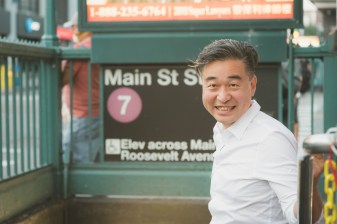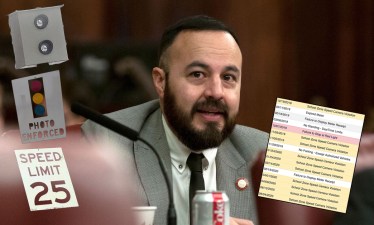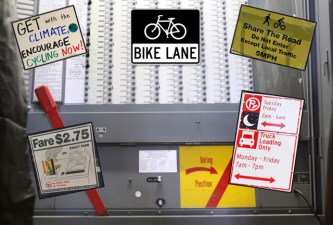City Council Candidates on the Issues: Corey Johnson, District 3
Campaign season in New York is already well underway. And when New Yorkers vote in the primary election on September 10, it won’t just be for the next mayor. They’ll also be choosing City Council members, borough presidents, the comptroller, and the public advocate.
In a series of candidate interviews, Streetsblog will be focusing on contested City Council races. In addition to proposing and voting on legislation, council members recommend Community Board appointees and occupy a powerful bully pulpit that can make or break proposals for safer streets and effective surface transit. Witness Dan Dromm’s support for “Diversity Plaza” in Jackson Heights, Melissa Mark-Viverito’s advocacy for East Harlem protected bike lanes, and Brad Lander’s defense of the Prospect Park West bike lane. Conversely, look at Peter Vallone, Jr.’s obstruction of a pedestrian plaza in Astoria, or the bellyaching from Staten Island’s Vincent Ignizio that’s made it harder for bus riders to use Select Bus Service.

On the West Side, three Democratic City Council candidates — Community Board 4 Chair Corey Johnson, civil rights lawyer Yetta Kurland, and Community Board 2 member Alexander Meadows — are vying to replace Christine Quinn, who is vacating the District 3 seat she first won in 1999. The district covers Midtown, Hell’s Kitchen, Chelsea and the West Village, an area that has been a hotbed of livable streets progress, from protected bike lanes to pedestrian plazas to parking reform.
Streetsblog sent questionnaires to the campaigns to get a better understanding of where the candidates stand on transit, traffic safety, and transportation policy. We begin in alphabetical order with responses from Corey Johnson and will run Yetta Kurland’s answers in a separate post. Alexander Meadows did not respond.
Streetsblog: Protected bike lanes on 8th and 9th Avenues involved extensive planning efforts with CB 4. Does the district benefit from the bike lanes and pedestrian islands? Would you like to see similar treatments on other avenues in the district?
Corey Johnson: I was proud to partake in the Community Board 4 planning efforts that resulted in the bike lanes and street redesign including sidewalk expansions and on-street bike parking. There are still areas with outstanding safety concerns that I will continue to push DOT to address but I stand behind dedicated bike lanes as part of a more comprehensive plan that includes increasing mass transit options, reducing congestion, and enforcing traffic laws for cyclists, as well as for cars and trucks.
SB: The City Council will soon vote on changes to the Manhattan Core parking regulations. What direction would you like to see off-street parking policy take in the future?
CJ: In July 2012, I wrote a letter to City Planning Commission Chair Amanda Burden expressing the opinion of CB 4 that opening accessory parking to transient public use will negatively affect the pedestrian safety and quality of life in residential districts and encourage the building of excessive parking capacity. We need to reinforce the current market trends towards reduced parking demand and increased transit use, rather than add to parking availability that encourages driving and car oriented development and undermines the clean air and health objectives of PlaNYC 2030.
SB: Hudson River Park is slated for significant development on Pier 57, and potentially Pier 40. Do you think this will impact the West Side Greenway, a major active transportation route?
CJ: The proposal for Pier 57 will bring much needed revenues to the Hudson River Park while creating a vibrant new marketplace and cultural icon out of the unutilized pier as well as boost accessible open space along the waterfront for runners and cyclists. The 75 parking spaces created will be restricted to those with business at the site and not to the public like at Chelsea Piers. The inclusion of speed tables and traffic signals with separate phase times will seek to minimize risk and disruption to those who use the Greenway.
SB: How can the City Council best use its powers to reduce vehicular deaths and ensure traffic justice citywide?
CJ: In February, following the tragic death of Shu Ying Liu while crossing 41st Street, I reiterated CB 4’s 5 year-old call for the implementation of split phase signals at this and other deadly intersections. The DOT needs to be more responsive to the community desire for safety measures and if necessary work with the Council to secure the capital funds for such critical projects. As the recent tragic loss of the Glauber family in Brooklyn also demonstrated, further steps need to be taken to keep those with histories of vehicular misconduct off the roads. The unanimous resolution passed by the City Council Transportation Committee in support of the successful loophole closure in Hayley and Diego’s law is an important step in a process where too frequently the laws and purse strings are controlled from Albany.
SB: The MTA is a state agency, but what actions would you like to see the City Council take to fund and expand transit service?
CJ: Unfortunately, NYC is incredibly limited in our control of our own mass transit system but we can make strides in strengthening and quickening the bus network through building additional bus lanes and expanding Select Bus Service and Bus Rapid Transit. The city contribution to the MTA has fallen over the past two decades and our commitment to our transit infrastructure must be reinvigorated. The proposal to redirect corporate subsidies from developments that prioritize parking to those meeting rigorous transportation benchmarks like those required by the CRA/LA should be implemented.


